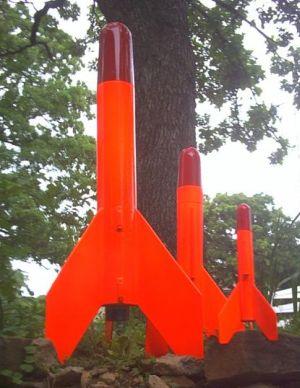Scratch 3x Rock-A-Chute Mark II Upscale
Scratch - 3x Rock-A-Chute Mark II {Scratch}
Contributed by Dennis McClain-Furmanski
(by Dennis McClain-Furmanski - 06/04/05)
Brief:
3x upscale of Rock-A-Chute Mark II, the first model rocket.

Construction:
The parts include:
- 3" PML phenolic airframe
- Custom turned hardwood nose
- 1/8" basswood fins glassed with Aerosleeve fiberglass sleeve
- 1/4" ply centering rings
- 38mm PML phenolic motor tube
- ACME conformal 1/4" launch lugs
- 8 feet of 5/16" tubular nylon shock cord
- Slimline 38mm retainer with 29mm adapter
After doing the 2x mid-power upscale of the Rock-A-Chute to go with my Semroc clone of the Mark II, I set out to complete the series with a high power version. Going by the details provided by the Semroc kit I designed this one around 3" phenolic tube from PML. The tube is a good choice, but my decision to slot it myself by hand, was not. I wore my hand out several times while cutting each of the slots with a hobby knife. I now buy my tubes pre-slotted.
The design and build was straight forward for a simple 3FNC high power design. The fins are through the wall to the motor tube and were glassed with 3" fiberglass sleeve from Aerosleeve. This is a coarse weave and required a fair amount of SuperFil to fill in. Not something I'd recommend, but another point where I went after maximum hands on building.
The shock cord was tied around the motor tube and run between the body and edge of the forward centering ring via a notch in the ring. This was glued into the aiframe and the fins fitted and filleted one at a time. JB Weld was used on all parts that came in contact with the motor tube so there wouldn't be any heat problems. All other epoxy was Devcon 2-ton. After the fins were set, the rear centering ring was glued in and the Slimline put in place.
The nose cone was custom turned out of hardwood by Gordon "Sandman" Angello of Roachwerks. It is a work of art. It was a shame to cover that nice wood finish with crass red gloss paint, but this was after all a reproduction. The heavy screw eye in the nose was reinforced by painting epoxy around and through the eye to prevent it from unscrewing or pulling out. Rather than going with a scale launch lug (it would have been roughly BT55 sized), I went with ACME conformal launch lugs. These and the Slimline motor retainer are the only outward violations of the strict upscale.
Finishing:
The spirals in the airframe were filled by covering the entire tube with spackle. Spackle was also painted on the fins to fill any small bits not quite filled by the SuperFil. This was then sanded down and primed. The paint job was predetermined by the upscaling with the body and fins all fluorescent orange and the nose cherry red. After painting and drying it was all coated several times with Minwax Polycrylic. This turned out to be a "gotcha" as the Polycrylic made the fluorescent paint mottled, so that it appears there are different shades of orange. Not a real bad looking effect, but certainly not perfect.
Flight:
I put in a Nomex ejection protector from Giant Leap, so no wadding was required. I used a Covert Recovery CR-4 17" parabolic chute for recovery attached with dual quick-links.
Simulation of 50 ounces with a G64 for the rocket plus 29mm adapter and RMS motor gave an altitude of 760' with apogee at 6.5 seconds. I went with a G64-7 for the test flight.
The flight went as expected, but the ejection was delayed and deployment was 2 seconds late with 3 pounds of rocket whistling downward.
Recovery:
When the ejection did go off, the chute deployed very hard, but the rocket stopped dead in the air then came down normally. The dual quick-links (1/8", rated at 220 lbs each) was probably a good idea. I haven't seen them fail before, but I suspect it might have if I'd only used one.
After recovery, it turned out there were two small zippers, 180 degrees apart. These were easily repaired.
Summary:
Although a "primitive" design, the Rock-A-Chute profile is a good one and consistently flies well. This version proves it scales up successfully. It is by no means a high performance design, but it's still a crowd pleaser. A CON was a choice of mine, not a function of the design which was choosing to slot the phenolic airframe tube by hand with a knife. Bad idea.
Related Products
 |
 |